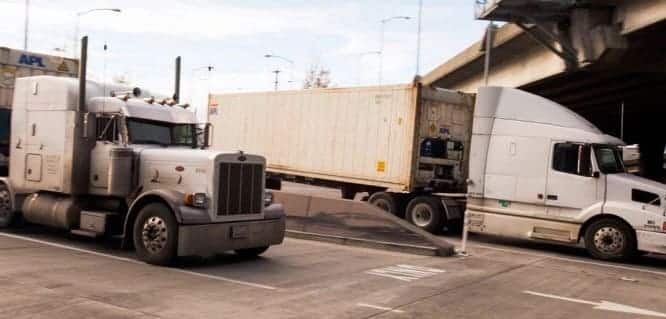As backlogged supply chains generate shortages in materials and parts, demand for moving freight across the U.S. is high. From retailers keeping shelves stocked to manufacturers sourcing raw materials, businesses are currently paying a premium to get products where they need to go. Rather than shipping goods by train, which is more fuel-efficient and economical, companies are “booking trucks on the spot.” As a result, large truck capacity is tight and expected to remain so through 2022. Adding to the situation are e-commerce sales, truck equipment shortages, and a struggling labor market. Finding enough drivers to meet demand has been difficult for already under-pressure trucking companies.
Rising freight volume translates to an increase in the number of large trucks on the road. While this may be good for commerce, the presence of more large trucks has safety implications. An increase of even 1% in truck traffic volume leads to a disproportionately higher increase in severe crash probability. This was found to be the case as overall traffic volume decreases.
Americans drove less in 2020 due to the pandemic, yet serious injury and fatality crashes grew exponentially. NHTSA reports automobile deaths increased nearly 8% in 2020, and 18.4% in the first six months of 2021. One category that bucked this trend was large truck fatalities. Fatalities in crashes involving a large truck declined by 1%. That said, large trucks accounted for roughly 9% of all vehicles involved in fatal crashes and 5% of all vehicles involved in injury and property-damage-only crashes.
Last month, the National Highway and Safety Administration (NHTSA) disclosed recent important traffic safety findings on large trucks. These findings were from data collected nationwide in 2020.
- 4,965 people were killed in crashes involving large trucks and approximately 146,930 individuals were injured. Nearly 440,000 large trucks were involved in police-reported crashes.
- 71% of people killed in large-truck crashes were occupants of other vehicles. 17% were occupants of large trucks and 13% were non-occupants including vulnerable road users.
- 76% of the fatal crashes involving large trucks occurred on weekdays and on interstates. Of these crashes, 72% happened between 6 a.m. and 6 p.m.
- 3% of drivers of large trucks involved in fatal crashes had blood alcohol concentrations (BACs) of .08 grams per deciliter (g/dL) or higher. This figure is significantly lower than drivers of other vehicle types involved in alcohol-related, fatal crashes (27% for motorcycles, 23% for passenger cars, and 19% for light trucks).
- Drivers of large trucks involved in fatal crashes had a marginally higher percentage (21.3%) of previously recorded crashes compared to drivers of other vehicle types (motorcycles, 20.5%; passenger cars, 19.7%; and light trucks, 17.3%). That said, they had the lowest percentage of previous DWI convictions comparatively.
- Drivers of large trucks in fatal crashes were less likely (7.3%) to have previous license suspensions or revocations than other vehicle types (motorcycles, 20.5%; passenger cars, 15.8%; and light trucks, 12.6%).
- In Washington State, 7.6% of all vehicles involved in fatal crashes were large trucks. This equates to a total of 65 individuals killed. By comparison, in Wyoming, 20% of all vehicles involved in fatal crashes were large trucks, and 4% in the District of Columbia. Texas saw the highest number of total fatalities at 643.
According to the American Trucking Association’s U.S. Freight Transportation Forecast to 2022, it is estimated that freight tonnage will increase 24% this year. This tonnage is predicted to result in a 67% increase in revenue, largely within the trucking industry.
E-commerce will continue to drive retail sales. The trucking industry is also being impacted by supply shortages, inflation, high prices, and labor shortages. Most of these issues can be traced back to COVID-19. Solutions for ensuring safety include measures such as easing the burden on truck drivers and improving operational efficiency.
Driver retention continues to be a challenge. Even with an effort to increase commercial driver’s licenses (CDLs) issued, the pressure on trucking companies and their drivers to increase productivity is persistent. Adequate compensation tops the list of driver expectations. Increased revenue should in theory equate to better pay for truck drivers. Keeping drivers in the industry will require that companies prioritize driver well-being and safety. This includes utilizing ergonomically designed cabin features, wellness checks, and PPE as well as time-saving technologies and apps that support workflow and optimize routes. Investing in safe work environments and ample rest areas for truck drivers can improve roadway safety for all motorists and vulnerable roadway users.
Despite the uncertainty in the economy and volatility in the trucking industry, higher freight volumes mean more large trucks on the roads. Savings lives and preventing injuries will continue to require effective safety standards, education, and enforcement. Given the correlation between increased truck volume and crash risk, commercial trucking companies and their drivers carry a heightened responsibility for the safety of all motorists and other vulnerable road users.
Coluccio Law is a leading law firm representing the victims of truck accidents. Kevin Coluccio is the only Washington State-based attorney certified by the National Board of Trial Advocacy as a Truck Accident Attorney
Recommended Article: Most Dangerous Roads in WA




